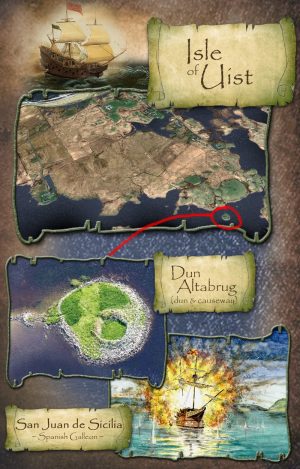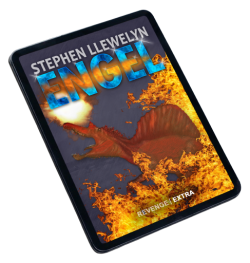a bit more about CURSED
Author's Notes & Featured Creatures
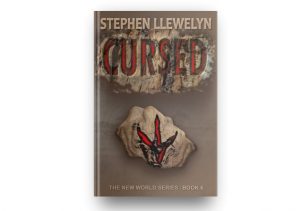
THE DINOSAURS
Many of the dinosaurs in this book have been discussed previously. There was, of course, a whole ecosystem’s worth of wonderful creatures in Cretaceous Egypt, but as those elements of the story took place over a relatively short period, many of the animals that appeared in the last three books are not merely the same species; often they were the same animals – locals, as it were. For example, the giant Carcharodontosaurus saharicus, the giant crocodilian Sarcosuchus imperator and the rowdy pack of Rugops primus.
DISCOVERIES IN EGYPT
Carcharodontosaurus saharicus, suffice to say, was another of the large theropod carnivores discovered by Ernst Stromer during his remarkable Egyptian excavations of 1911-14. Just to give a basic mind’s eye picture, it was broadly shaped and sized comparably to Tyrannosaurus rex, although not directly related. T rex joined the fossil record more than thirty million years later and was overall, a stronger, more advanced and dangerous animal.
Rugops primus – it is perhaps worthy of note that no actual evidence exists to prove that they were social or moved about in packs – at least, not at the time of publishing. As Rugops was comparatively weak in the jaw, I took a liberty and made them hunt, or scavenge, in numbers. From a fictional storytelling perspective, I think this makes them a scarier proposition, too. If they really did go about in groups a dozen strong, they would have been a right handful!

Spinosaurus aegyptiacus, a dinosaur that probably requires little introduction these days. Apologies if it seemed like ‘icon mashing’, but I just couldn’t resist draping one across a pyramid – two ancient fascinations for the price of one, with a later nod to Agatha Christie’s ‘Death on the Nile’, for good measure!
TITANOSAURS
Paralititan stromeri were large sauropod dinosaurs – sauropods were the long neck, long tail varieties. They were titanosaurs related to Argentinosaurus, and others, from earlier books in the series. They were probably a little smaller than Argentinosaurus, but still huge. Only fragmentary evidence exists for this once extraordinary species, so estimates vary wildly between 20-60 tons in weight and 20-32 metres in length. Hopefully a more complete specimen will be found in the future to fill in the gaps. Dispersed over several continents, the titanosaurs presumably shared common ancestors from before the breakup of Pangaea into the continents we recognise today. A process that began back in the Triassic Period, a hundred million years or more before the Cretaceous setting for this story. Again, as the name suggests, they were discovered and named by Ernst Stromer. He must have won the dino-lottery during those brief years of the early 20th century. Sadly, the majority of his finds, including the most complete remains yet discovered of the mighty Spinosaurus aegyptiacus, were destroyed in the Allied bombing of 1944. As the song says, ‘War – what is it good for? Absolutely nothing!’ Well, at least it stopped Hitler, eventually. Pity it didn’t end there.
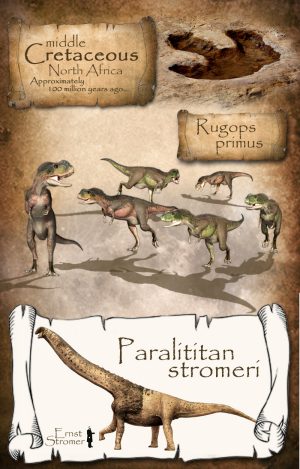
Afromimus tenerensis, small and ostrich-like, this little creature was an ideal choice for a dinosaur-mimicking robot spy. Extremely fast and a relative minnow in the age of giants, it would have been easy to overlook. Afromimus was an earlier North African relative of the more famous Ornithomimus velox. They must have been graceful, bird-like creatures, as implied by the name.
Ouranosaurus nigeriensis I also mentioned in a previous book. However, aside from being an ancestor to the hugely successful duck-billed dinosaurs, who mainly came later, I find these creatures interesting in that they share such a similar (at least, superficially) sail on their backs with Spinosaurus. Ouranosaurus was herbivorous. (As you will no doubt have gleaned from this book, Spinosaurus wasn’t!) That both had a similar body plan and were from the same area raises the question of perhaps another common ancestor. Perhaps divergence came as a necessity of lifestyle – although Spinosaurus aegyptiacus was far larger and a whole lot meaner! The dorsal sail has long been pondered by experts, some believing it functioned as a thermoregulator for heating or cooling the blood – dogs use a similar process, instead passing blood through the pads in their paws to cool themselves down. (Quite often, the little darlings get too excited to drink cool water, even when they should, so cooling their paws on a cold surface or in a stream is a good idea if they’re overheating. Health and Safety Notice: DO NOT TRY THIS WITH A SPINOSAURUS!) Other scientists have suggested that such a skeletal construct may have supported a hump of muscle or fat rather than a sail, and like a camel, it might have been used for energy or fluid storage in times of scarcity or drought. There’s still just so much to learn about dinosaurs. We’ve barely scratched the surface, and I think that’s a large part of the fascination for so many of us – once you recover from how vast and dangerous some of the dinosauria were.
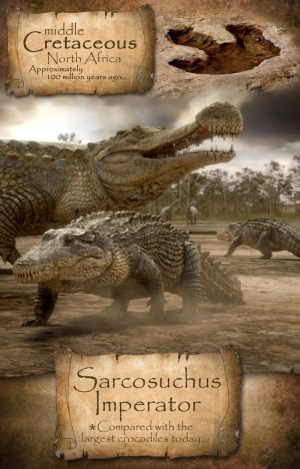
Sarcosuchus imperator. Again, closely related and contemporaneous with South America’s Sarcosuchus hartti from earlier books in the series, suggesting common ancestry. These giant crocodiles were easily large enough to dispatch an unsuspecting carnivorous Rugops, or herbivorous Ouranosaurus. Each prey animal growing to roughly seven metres long, the deadly Sarcosuchus would have possibly preyed on both – quite probably when they needed to drink, as crocodiles do today. Imagine, if you will, Sarcosuchus imperator hiding just below the surface, or maybe looking like a log floating downstream. Well over twice the length and many times the size of even the largest modern-day saltwater crocodile (Crocodylus porosus), they would have guaranteed that no one ever wasted time on idle chatter around the water cooler in Cretaceous Africa! It’s believed that the comparatively slender nature of the Sarcosuchus jaw would have made it impossible to ‘death roll’ its prey, as modern crocodiles do. Rather, the jaw structure leads palaeontologists to believe that Sarcosuchus hunted large prey, such as dinosaurs, killing with brute force rather than shaking them apart, like their modern descendants.
ENGEL
*Corporal Heinz Engel is introduced to the series in ENGEL | REVENGE EXTRA. See also MAPUSAURUS | DINOSAUR EXTRA in the New World Series Short Stories collection, available for free download.
HISTORIC EVENTS & LOCATIONS
Geek alert: Name change from São Paulo to New World – São Paulo was the original name for the second Defiant, in Star Trek Deep Space Nine – my homage (Starfleet’s famous engineer, Chief Miles O’Brien, hated the new carpets, too).
On the subject of ships, the 800-ton Spanish galleon, San Juan de Sicilia, really did explode and sink on November 5th, AD1588. (It’s unrelated, but perhaps ironic, that we celebrate Guy Fawkes Night [Bonfire Night] on November 5th in Britain, to commemorate the Gunpowder Plot of 1605 which didn’t actually go off!) The late 16th century, and especially 1588, was marked by turbulent North Atlantic storms. They’re believed to have been an effect associated with a period that has become known as the ‘Little Ice Age’. Despite the purposes of the Armada, far more sailors were killed by the weather than enemy action. Near the end of September 1588, the San Juan de Sicilia anchored off the west coast of Scotland, near the Isle of Mull, in Tobermory Bay. Though she was as yet undamaged, her crew were short of water and supplies. Her senior officer, Diego Tellez Enríquez, made a deal with a local Scottish lord, Lachlan MacLean of Duart. MacLean would provide the supplies the San Juan de Sicilia badly needed and Enríquez would provide armed men to help settle MacLean’s feuds with his neighbours. Enríquez was no fool – unwilling to trust a man who attacks his neighbours, he insisted on hostages to guarantee the Scottish lord’s good faith. The San Juan de Sicilia remained in Tobermory Bay for a little over a month, during which time Enríquez’s Spanish troops attacked and ravaged the islands of Rùm, Eigg, Canna and Muck, going on to lay siege to Mingary Castle on the mainland. At some point during this period, it was discovered, or assumed, that one of the merchants charged with the reprovisioning, John Smollet, was actually in the pay of Sir Francis Walsingham – Elizabeth I’s ‘spymaster’. The San Juan de Sicilia never actually set back to sea, for on November 5th she exploded while still at anchor, killing almost everyone aboard, including the hostages. The fifty or so survivors continued in service to MacLean until he finally had them shipped back to Spain a year later. Details of the ship’s destruction are sketchy, its actual reason, unknown – though the wreck still intrigues marine archaeologists to this day.
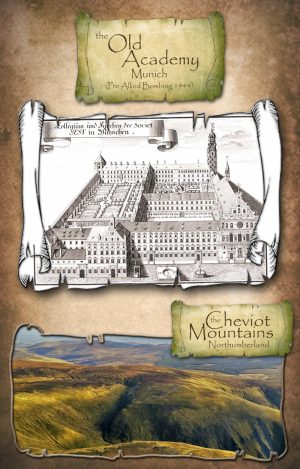
The Old Academy, Munich was destroyed by Allied bombing, as mentioned above. It was actually destroyed in the April of 1944, rather than the June explosion described in this story – it would have been nice to tie in exactly, but it just didn’t quite work with the timeline for the rest of the story.
The Nazis did indeed invade the Netherlands on May 10th, 1940, despite the Netherlands being neutral at the time. The occupation began comparatively softly, with trade deals from the hand wearing the velvet glove, but deteriorated throughout the war to a point where the population were starving by 1945. 70% of the Netherlands’ Jews were killed during the Second World War. Active resistance, which began with just a handful of fighters, grew throughout the occupation – perhaps unsurprisingly. From this came the idea for my ‘Order of the Silver Cross’ Nazi hunters, to honour the courage of those concerned. The Order in my books was not real, just a device I used to tie various characters to an overall thread throughout the story, but there certainly were real heroic groups who fought with whatever they had, to free their people from tyranny.
Reinhard Heydrich was one of the principal architects of the Holocaust. As previously discussed, he was a monster, arguably the worst of Hitler’s entire regime. Mortally wounded in Prague on May 27th, 1942, he was ambushed by Czech and Slovak soldiers sent by the Czechoslovakian government-in-exile, whose troops were trained by the British Special Operations Executive. Heydrich died from his injuries a week later, but the Nazi response, wreaked erroneously on villages thought to be linked to the attack, and a wider resistance, was terrible. Indeed, Heydrich probably deserves more ‘infamy’ than he actually receives. Hitler, looking for a pretext to invade Poland in 1939, tasked Heydrich, Himmler and Heinrich Müller with designing a false flag operation. The dastardly scheme they cooked up involved a fake attack on a German radio station at Gleiwitz on August 31st, 1939. Wearing Polish uniforms, 150 German troops carried out several attacks along the border with Poland. Heydrich masterminded the plan, giving Hitler his excuse to invade Poland and the rest, as they say, is history – although you might be forgiven for thinking it sounds familiar.
Josef Mengele is a name most will already be familiar with, I’m sure. He is also remembered under the quaint moniker of the ‘Angel of Death’ – more than just a Slayer song. His penchant for carrying out genetic experimentation on twins was revealed in a recent documentary that followed the life of a Holocaust survivor. He would use one for his sick experiments until that twin died – and these were often children – whereupon he would murder the other twin to compare their anatomies as part of his ‘research’.
Briefly following on from that, it’s so difficult to imagine such atrocities and yet… with war crimes practically accompanying our TV dinners right now, almost a century later, the original plot I had noted for this part of the story arc fast became unpleasant to write. It was just too ‘close’, as I mentioned in the preface at the beginning of this book.
That said, some people simply found themselves on the ‘wrong side’ because of where they were born. During the Second World War, Erich Alfred Hartmann, or ‘Bubi’ (roughly translated, ‘The Kid’), was a German pilot and the most successful fighter ace to date. History remembers him as a skilled pilot and an honourable serviceman, unlike the Nazis shamed above. A master of stalk-and-ambush tactics, he honed the technique of ambushing and firing at close range, rather than dogfighting. “Fly with your head, not with your muscles,” was the famous advice he passed on to new recruits, after a rude awakening which would have gotten him killed had he not been confined to barracks. During his time with the Luftwaffe, he flew 1,404 combat missions and engaged the Allies in aerial combat 825 times. He was credited with 352 kills; 345 Soviet and 7 American. Hartmann survived 16 crash landings, the causes being mechanical in nature, or damage due to impacts with flying debris from aircraft he himself had shot down. He was never brought down by direct enemy action. He was highly decorated and by 25th August, 1944, Hartmann had earned the coveted Knight’s Cross of the Iron Cross with Oak Leaves, Swords and Diamonds for 301 aerial victories – at that time, Germany’s highest military decoration. As discussed within this story, he was tried by Russia for war crimes against civilian targets, which he denied all his life. He seems to have been convicted for the costs to Russia in ‘expensive’ aircraft and for what must have been quite a dent to Russian pride – after all, he had shot down a lot of their planes. Apparently, the judge at his trial said his attempts to defend himself were “a waste of time.” He was initially sentenced to 20 years’ imprisonment, later increased to 25. He actually served 10 of those years, in various Soviet prisons and Gulags until his release in 1955. In 1997, the Russian Federation exonerated him of all charges during the democratic Yeltsin years. Sadly, this was a posthumous admission as Hartmann died in 1993. Of all his accomplishments, he was most proud of the fact that he never lost a wingman – although, technically, he did lose Major Günther Capito in 1943, who nevertheless lived on to fly again, until the end of the war. Now Erich Hartmann is cut off from his native 1944 Germany and ensconced aboard the New World, it will be interesting to see where he ‘flies’ next.
THANK YOU
I hope you’ve enjoyed this sixth book of the New World Series, and wish you all a bright and hopeful future, wherever you are in the world.
Thank you so much for reading,
Stephen
